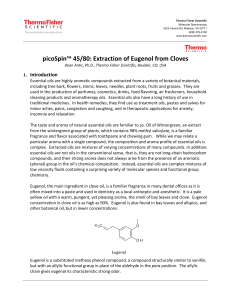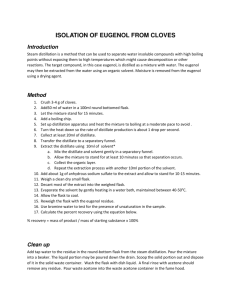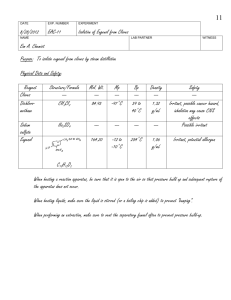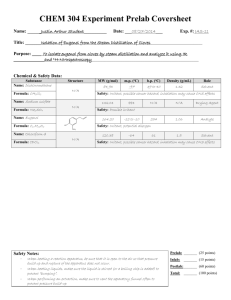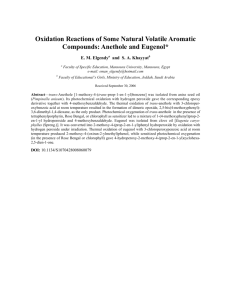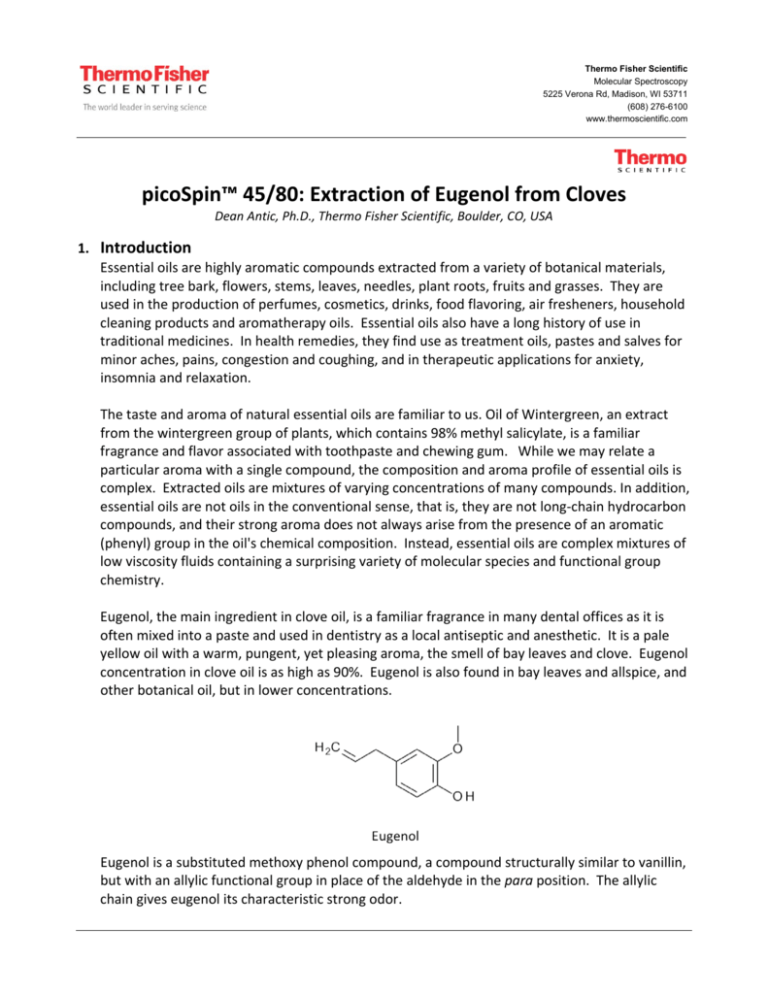
Thermo Fisher Scientific
Molecular Spectroscopy
5225 Verona Rd, Madison, WI 53711
(608) 276-6100
www.thermoscientific.com
picoSpin™ 45/80: Extraction of Eugenol from Cloves
Dean Antic, Ph.D., Thermo Fisher Scientific, Boulder, CO, USA
1. Introduction
Essential oils are highly aromatic compounds extracted from a variety of botanical materials,
including tree bark, flowers, stems, leaves, needles, plant roots, fruits and grasses. They are
used in the production of perfumes, cosmetics, drinks, food flavoring, air fresheners, household
cleaning products and aromatherapy oils. Essential oils also have a long history of use in
traditional medicines. In health remedies, they find use as treatment oils, pastes and salves for
minor aches, pains, congestion and coughing, and in therapeutic applications for anxiety,
insomnia and relaxation.
The taste and aroma of natural essential oils are familiar to us. Oil of Wintergreen, an extract
from the wintergreen group of plants, which contains 98% methyl salicylate, is a familiar
fragrance and flavor associated with toothpaste and chewing gum. While we may relate a
particular aroma with a single compound, the composition and aroma profile of essential oils is
complex. Extracted oils are mixtures of varying concentrations of many compounds. In addition,
essential oils are not oils in the conventional sense, that is, they are not long-chain hydrocarbon
compounds, and their strong aroma does not always arise from the presence of an aromatic
(phenyl) group in the oil's chemical composition. Instead, essential oils are complex mixtures of
low viscosity fluids containing a surprising variety of molecular species and functional group
chemistry.
Eugenol, the main ingredient in clove oil, is a familiar fragrance in many dental offices as it is
often mixed into a paste and used in dentistry as a local antiseptic and anesthetic. It is a pale
yellow oil with a warm, pungent, yet pleasing aroma, the smell of bay leaves and clove. Eugenol
concentration in clove oil is as high as 90%. Eugenol is also found in bay leaves and allspice, and
other botanical oil, but in lower concentrations.
Eugenol is a substituted methoxy phenol compound, a compound structurally similar to vanillin,
but with an allylic functional group in place of the aldehyde in the para position. The allylic
chain gives eugenol its characteristic strong odor.
Essential oils are extracted, depending on the nature of the botanical material, by a variety of
techniques, including expression (cold-press), solvent, enfleurage (cold-fat) and supercritical
fluid (SCF) extraction, and distillation. For instance, citrus essential oils are often extracted by
cold pressing, a technique similar to household juicers. Solvent, SCF and enfleurage extraction
are used with delicate materials, such as flower petals, and for making absolutes. Water
distillation is employed with flowers, and indirect steam distillation is often used with leafy
materials, seeds and pods. Most essential oils are extracted by direct or indirect steam
distillation.
Steam distillation is a co-distillation technique that uses live steam to separate components of a
mixture. It is effective at extracting high boiling-point components of essential oils, where
boiling points are as high as 200°C. Yet the oil vapors themselves are closer to 100°C, thus
helping to preserve the structural integrity of the compounds. It allows distillation to be
performed at temperatures below the boiling points of the individual components. Indirect
steam distillation is a technique used for generating steam in situ, where the water level is kept
below the plant material.
Co-distillation is distillation of components of a mixture that are immiscible with water. Steam
vaporizes the high-boiling essential oils and the hot vapors condense back into a liquid, along
with water, as they pass through a cooling system. Since the oils are immiscible in water a twophase distillate is produced, a water layer and an oil layer. The oil is usually less dense and
floats atop the water. The aqueous layer can then be siphoned off using a separatory funnel. If
an emulsion develops, as is often the case in small-scale distillation, the immiscibility of the
hydrophobic oil makes extraction and isolation of the product with a non-polar organic solvent
highly effective.
2. Purpose
The purpose of this experiment is to extract eugenol from whole cloves by co-distillation with
indirect steam, steam that is generated in situ. Eugenol will be extracted from the distillate
with dichloromethane and analyzed using the Thermo Scientific™ picoSpin™ 45 or 80 NMR
spectrometers.
3. Literature
Adapted from Williamson, K. L.; Minard, R.; Masters, K. M. Macroscale and Microscale Organic
Experiments, 5th ed., Houghton Mifflin Co., 2007.
4. Pulse Sequence
In this experiment, we use a standard 90° single pulse experiment. The recycle delay time (d1)
is adjusted to maximize signal intensity prior to signal averaging the next FID.
2
Sequence: d1−[ °−aq−d1]ns
°: Pulse rotation angle (flip angle)
FID: Free induction decay
d1: Recycle delay (µs) for spin-lattice
relaxation
p1: R.F. transmitter pulse length (µs)
aq: Acquisition time (ms)
ns: # of scans (individual FIDs)
5. Procedures and Analysis
Time requirements: 5 hrs
Difficulty: Moderate
Sample: Eugenol
Equipment/materials:
• Thermo Scientific™ picoSpin™ 45 or 80
• Cloves, whole
• Dichloromethane (CH2Cl2)
• Tetramethylsilane (TMS; (CH3)4Si)
• Steam distillation apparatus
• 250 mL round bottom flask
• 100 mL Erlenmeyer flask
• Claisen adapter
• Condenser w/water jacket
• Three-way adapter
• Vacuum adapter
• Clamps (flask or Keck)
• Ring stand, ring clamp, iron ring
• Thermometer
• Thermometer adapter
• Boiling chips
• Mnova NMR Processing Suite
• picoSpin accessory kit:
• Port plugs
• Syringe port adapter
• Drain tube assembly
• 50 mL beaker
• 1 mL polypropylene syringes
• 22 gauge blunt-tip dispensing needles
• 7 mL vial
Molecules:
3
Physical data:
Substance
FW (g/mol) Quantity
cloves, whole
25 g
dichloromethane
84.93
45 mL
sodium sulfate, anhydr.
tetramethylsilane (TMS)*
88.22
3 drps
chloroform-d (CDCl3) w/1%TMS*
120.384
1 mL
acetone-d6 (Ac-d6) w/ 1%TMS*
64.12
1 mL
*Optional NMR solvents and chemical shift reagent
MP (°C)
BP (°C)
Density (g/mL)
-96.7
39.6
1.3266
-99
-64
-94
26-28
61
56
0.648
1.50
0.872
Safety Precautions
CAUTION Eye protection should be worn at all times while using this
instrument.
CAUTION Avoid shock hazard. Each wall outlet used must be equipped with a 3prong grounded outlet. The ground must be a noncurrent-carrying wire connected
to earth ground at the main distribution box.
4
Experimental
Distillation procedure
• Set up a steam distillation apparatus (Figure 1). In this setup, steam is generated in situ.
Figure 1 Steam co-distillation apparatus
• Use a sand bath of heating mantle as a heat source.
If using a sand bath, the amount of heat transfer to the flask can be controlled by piling
up or removing heated sand from around the flask.
• Place 25 g of whole cloves in a 250 mL round-bottom flask, add 100 mL of water.
• Heat the flask strongly until boiling starts, then reduce the heat enough to prevent foam
from being carried over into the receiver.
• Use an Erlenmeyer flask as a receiver.
• Do not heat the solution to dryness; periodically add a few mL of water from the
separatory funnel.
Keeping the round-bottom flask about 1/2 to 2/3 full throughout co-distillation will yield
the best results. Be careful not to allow the distillate from boiling over into the Claisen
head and contaminating the distillate.
• Distill off approximately 60 mL of distillate.
5
• Turn off the sand bath and let the system cool.
Solvent extraction procedure
Eugenol will be extracted from the distillate using dichloromethane.
• Place the 60 mL of distillate in a 250 mL separatory funnel.
• Extract with three 15 mL portions of dichloromethane.
For the first two portions, shake the separatory funnel vigorously. This will create an
emulsion; draw off the clear lower layer to the emulsion line for the first two extractions.
Shake the third portion less vigorously; allow a longer period for the layers to separate.
• Combine the dichloromethane extracts (discard the aqueous layer).
• Add enough anhydrous sodium sulfate so that it no longer clumps together. It should
appear to settle as a dry powder
• Swirl the flask for a couple of minutes.
• Decant the solvent into a clean, dry Erlenmeyer flask.
• Add a wood boiling stick.
• Evaporate the solvent on a steam bath in a hood. The residue of crude clove oil will be
used in the NMR analysis.
• Disassemble and clean the distillation apparatus and all glassware.
• Prepare samples for NMR analysis.
Preparing Samples
One sample of eugenol will be prepared for analysis. The sample can be analyzed as a neat
liquid. The 1H NMR chemical shift from the methoxy singlet (3.72 ppm) in eugenol can be
used as an internal chemical shift reference. Alternatively, a few microdrops of TMS (0
ppm) can be added to the sample, or eugenol can be diluted up to 50% with CDCl3
containing 1% TMS. The sample preparation guide and spectra presented are for spectra
acquired from a neat sample; spectra are internally referenced.
• Sample 1: To a labeled vial measure about 0.20 mL of eugenol. (Optional: Add a couple
microdrops of TMS). Cap and save for NMR analysis.
Instrumental procedure
The general procedure for sample analysis using a picoSpin NMR spectrometer is as follows:
Shim
Prepare
Inject
Acquire
Analyze
6
Shim
• Ensure the NMR spectrometer is shimmed and ready to accept samples.
Pre-sample preparation
• Displace the shim fluid from the picoSpin capillary cartridge with air.
• Flush the cartridge with 0.1 mL of chloroform, and then displace the solvent with an air
push. A small signal in your sample spectrum may appear at 7.24 ppm due to residual
chloroform, it can be used to shift reference the spectrum.
• Set up the onePulse script according to parameters listed in the Pulse Script table.
Injection
• Using a 1 mL disposable polypropylene syringe fitted with a 1.5” long, 22-gauge blunt-tip
needle, withdraw a 0.2 mL aliquot of sample.
• Inject about half the sample. Ensure all air bubbles have been displaced from the cartridge
by examining the drain tube.
• Cap both the inlet and outlet ports with PEEK plugs.
Acquire
• Execute the onePulse script according to the values in the table of parameters provided
• Once the onePulse script has finished, prepare the cartridge for the next user by
displacing the sample from the cartridge according to the following protocol: air, solvent,
air.
Pulse Script: onePulse
Acquisition parameters apply to both the picoSpin 45 and picoSpin 80 spectrometers. Use
the tx frequency (tx) and pulse length (p1) appropriate for each system.
Parametera
tx frequency (tx)
auto tx
auto tx offset
scans (ns)
pulse length (p1)
acquisition points (aq)
rx recovery delay (r1)
recycle delay (d1)
bandwidth (bw)
post filter attenuation (pfa)
zero filling (zf)
align-avg. data
phase correction (ph)
exp. apodization (LB)
JCAMP avg.
JCAMP ind.
max time to plot
Value
proton Larmor frequency (MHz)
270 Hz (pS45), 380 Hz (pS80)
4, 10 or 16
Instrument specific 90° pulse length
3000
500 µs
6s
4 kHz
11 (10)b
8192
0 degrees (or any value)
0 Hz
Unchecked
250 ms
7
min freq. to plot
-200 Hz
max freq. to plot
+1000 Hz
max plot points
400
live plot
a
Auto tx and auto tx offset are parameters introduced in picoSpin
software version 0.9.0. Parameter names and position in scripts
changed slightly in version 0.9.0. b Choose the instrument’s default
pfa value.
6. Processing
Download the experimental JCAMP spectra files and open them by importing into Mnova. The
free induction decay (FID) will undergo automatic Fourier transformation and a spectrum will
be displayed. To each spectrum, apply the following processing steps using the given settings:
Function
Zero-filling (zf) & Linear Predict (LP)
Forward predict (FP)
Backward predict (BP)
Phase Correction (PH)
Apodization
Exponential (LB)
First Point
Shift reference (CS)
Peak Picking (pp)
Integration (I)
Multiplet Analysis (J)
Value
16 k
From aq → 16 k
From -2 → 0
PH0: Manually adjust
PH1: 0
0 Hz
0.5
Manually reference
Manually Select Peaks
-
• Import each data file into the same workspace in Mnova. Manually apply Ph0 phase
correction to each spectrum.
• Manually shift reference each spectrum using Mnova’s TMS tool. Assign the methoxy
signal from eugenol (3.72), TMS signal (0 ppm), or residual chloroform signal (7.24 ppm).
• Identify and assign each signal in spectra.
• Save the Mnova document, print each spectrum and paste into your lab notebook.
7. Results
The 45 MHz and 82 MHz 1H NMR spectrum of eugenol (neat) is presented in Figure 2. The
spectra show several signal groups. Aromatic proton signals (C3, C5 & C6) appear between 6.57.2 ppm. The C3 proton is uncoupled and gives rise to a singlet (~6.77 ppm); it overlaps other
signals in this region thus complicating its assignment. Protons on C5 and C6 are spin coupled
thus generating a doublet of doublet multiplicity pattern. The downfield doublet of this pair
is unobstructed, whereas the upfield doublet overlaps the C3 signal.
8
Vinyl protons (H2C=CH) at C8 and C9 shift to 5.16 ppm and 6.05 ppm, respectively. The
expected first-order coupling pattern (a doublet of doublet pair) due to cis and trans coupling
of the terminal vinyl protons (C9; 5.16 ppm) to the C8 proton is not evident. This is likely to
due to the crude nature of the extracted product. In contrast, the C8 proton signal (6.05 ppm)
exhibits a resolvable complex multiple arising from cis and trans coupling to the terminal vinyl
protons (C9) as well as coupling to the allylic C7 proton.
The doublet structure, centered at 3.36 ppm, arises from spin-spin coupling of the methylene
bridge protons (C7) to a single internal vinyl proton on C8. The downfield shift to 3.36 ppm is
due to attachment of the C7 carbon to both a phenyl and a vinyl group.
The final signal group readily assigned belongs to the methoxy methyl functional group
(OCH3); it appears as a strong singlet at 3.73 ppm. One remaining signal appears at 6.36 ppm
in the 45 MHz spectrum and, roughly, at 6.53 ppm in the 82 MHz spectrum; this signal is likely
due to the phenol proton (PhOH).
9
Figure 2 Stacked, full 1H NMR 45 MHz (top) and 82 MHz (bottom) spectrum of steam-extracted
eugenol from clove oil (neat).
Table 1. 1H NMR Spectral Data
Figure
Compound
Signal Group
Chemical Shift (ppm)
Nuclides
Multiplicity
2
Eugenol
CH-CH2-Ar
CH3-O
3.36
3.73
2H
3H
doublet
singlet
CH2=CH
5.16
2H
multiplet
CH2=CH-CH2
-OH
Ar
Ar
6.05
6.35 (pS45), 6.53 (pS80)
6.77
6.5-7.2
1H
1H
1H
2H
multiplet
singlet
singlet
doublet of doublets
8. Comments
• The challenge in this lab is extracting sufficient quantities of eugenol.
10
• Collecting at least 60 mL of distillate can yield up to 2 mL of eugenol after extraction and
evaporating off dichloromethane.
• Should students not have sufficient sample after extraction and solvent evaporation, there
are two alternatives:
o Combine samples from larger groups of students,
o Follow the extraction procedure with store-bought clove oil using approximately 2 mL of
the essential oil, then compare pre- and post-extraction eugenol.
9. Own Observations
www.thermoscientific.com
© 2014 Thermo Fisher Scientific Inc. All rights reserved. All trademarks are the property of Thermo Fisher Scientific and its
subsidiaries. Specifications, terms and pricing are subject to change. Not all products are available in all countries. Please
consult your local sales representative for details.
Africa +43 1 333 50 34 0
Australia +61 3 9757 4300
Austria +43 810 282 206
Belgium +32 53 73 42 41
Canada +1 800 530 8447
China +86 21 6865 4588
FL52575_E_03/14
Denmark +45 70 23 62 60
Europe-Other +43 1 333 50 34 0
Finland/Norway/Sweden
+46 8 556 468 00
France +33 1 60 92 48 00
Germany +49 6103 408 1014
India +91 22 6742 9494
Italy +39 02 950 591
Japan +81 45 453 9100
Latin America +1 561 688 8700
Middle East +43 1 333 50 34 0
Netherlands +31 76 579 55 55
New Zealand +64 9 980 6700
Russia/CIS +43 1 333 50 34 0
Spain +34 914 845 965
Switzerland +41 61 716 77 00
UK +44 1442 233555
USA +1 800 532 4752
11

